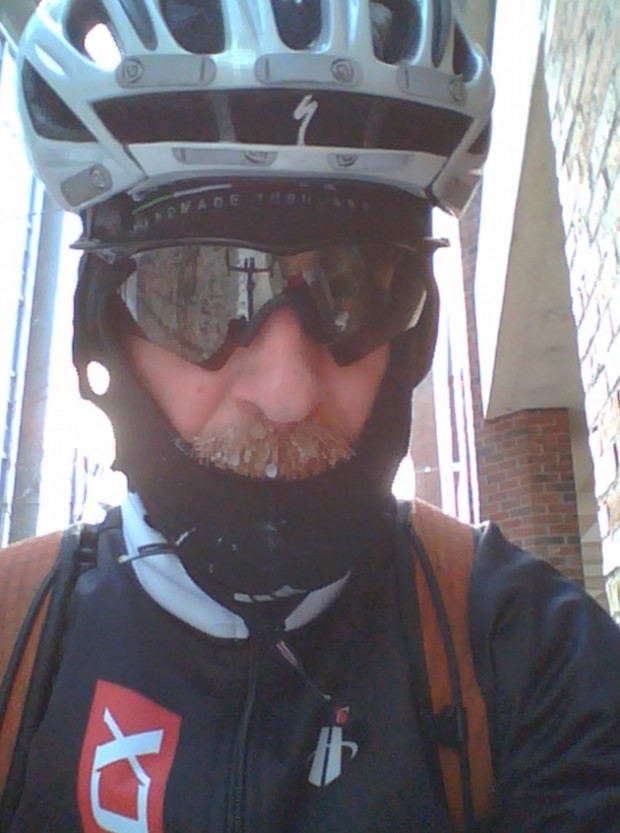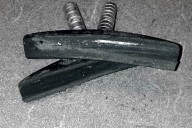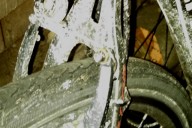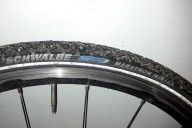Note: the featured image above is from last week’s commute, where the temperatures dipped to 6 degrees F.
Commuting when the temps start to dip below the freezing point is one of the more environmentally and physically rewarding times of the year to make the effort. Cars are at their most polluting and consume the most fuel until they reach operating temperatures, and in the winter any trip in the car is quite wasteful, and with the weather that we’ve had lately – specifically these “polar vortex events” – driving instead of biking the commute, the car may never warm up, and I can certainly go into the long list of why that is bad for the car. BUT lets focus on personal comfort. If the car isn’t garaged it is going to be cold getting in it. You could start it and let it idle for 5-15 minutes before getting in, but again, not the most responsible thing to do.
So you get dressed, jump in cold car, shiver until it warms up. Get to work, park. Walk in. So much coldness.
OR?
Start in the warm house, (I like to take my shower, especially in the winter, just before getting dressed to leave so that I’m as warm as possible), get suited up, hop on bike, start making heat as a by-product of your work pedaling, arrive nice and warm. Lock/park bike. And never be cold once, even on the coldest mornings. And it isn’t just being warm, being active when it is cold out gives you an extra burst of metabolism, which translates into being able to have that extra helping at dinner, or dropping that extra pound or two you’ve been trying to shed for a while. Exercise in the cold (even if you are completely bundled up) definitely cranks that metabolic furnace to high.
The reasons to commute by bike are rather exhaustive and not the point for today.
Clothing, that’s what is covered today, with a big but targeted brush stroke.
How do you dress when the temps dip down?
Weather. Weather. Weather.
If you haven’t figured it out by now you basically need to be your own meteorologist. Personally l start with http://forecast.weather.gov/ and their Hourly Weather Graph. It gives me a nice projection of all the factors for the whole day in one glance, temperature, wind speed and direction, and precipitation. http://forecast.io/lines/ is another source. Next place I check after the daily trends is the current weather, what is it actually doing just before getting dressed, and for that I find that http://www.wunderground.com/auto/wxmap/ works the best (especially when you add wind info to the weather stations).
Everyone has a personal threshold for tolerable temps, but on the bike you should be generating heat (if not, PEDAL HAHDAH), and dressing for a cold temp commute is just making sure you keep the heat in without sweating or letting the wind suck it out faster than you can make it. Individuals with Raynaud’s may find it more challenging to keep hands and feet warm, but it is still not a completely insurmountable obstacle. When I was taking my daughter to daycare in the trailer every day our low temp cut off was 18ºF/-7.8ºC. That was the temp at which after 50 minutes her hot water bottle heat sources would be cool and her cheeks just a touch cold. Sitting there bundled up in a trailer even with waterbottles full of hot water stuffed in the seat and by her feet it’s tough to stay warm. I suppose we could have pushed it colder but never did, and only had to resort to alternative means of transport once or twice.
Right now? My cut off?
I don’t have one. Last week the 6ºF/-14.4ºC commute was no big deal. Actually wound up with too many layers on my legs and overheating on the way in, which balanced being slightly underdressed on the top half. Even I don’t get the layers just right all the time.
Since we’re talking cold, not cool, temps where you shouldn’t really see any moisture, I’m not going to address wet commutes, that’s a totally separate pile of words.
Breaking it down there are really four main areas – Clothing, Head, Eyes, and Skin.
Starting with skin. Yes, there are times when it will be cold but maybe your face will still have a bit of exposed skin, maybe just a nose or the cheeks. I like to use non-petroleum skin protectant. Badger makes a few products, right now I’m using the one for hard working hands, a nice blend of oils and waxes that doesn’t suffocate the skin but still provides a good measure of protection against the brutal cold wind. Personally I strive to avoid anything with mineral oil, glycols, petroleum jelly/vaseline, and any lotions/coatings that have water/alcohol in them. Pure lanolin is a fantastic option but is a bit challenging to apply because it is so thick. A simple light coat of a nice saturated vegetable oil like avocado or palm or coconut oils actually works really well (also great for applying to your legs after shaving them). The goal is to provide a barrier to the wind while being very well tolerated by the skin. Exposed skin shouldn’t be left unprotected.
Eyes. Glasses work well. The bigger the lenses the better. Those old Oakley M-Frames with the heater lenses are great, little thin glasses are better than nothing but you will have more exposed skin. Many go with ski goggles, and they are a great option when the weather really gets nasty but I don’t have any and generally have found even a clear lens to be sufficient protection. Just something to keep the tears from forming and freezing. Take care of your eyes as it is hard to commute by bike when they don’t work.
Keeping with that area lets move to the head. How do you manage to keep the head warm? Some helmets, like a few Lazer models, have a nice plastic shell that snaps on, covering all the vents. This is a great way to decrease heat loss from the head. But if you don’t have a helmet with that option, simple packing tape works well to cover the vents. Go nuts and use reflective tape or bright duct tape for more visibility and creativity. But those same vents that keep you cool in the heat of the summer are your worst enemy in the winter, so cover ’em. There are separate helmet covers made by Gore-tex and a few other companies that go right over your helmet and may be a nice option that is easily removable if your temp ranges are very diverse during the day.
Now inside the helmet, there are specific winter liners you can get too, depending on the make and model you have, but you can often get away with a nice thin wool cap, or even a fleece cap under the helmet. It is important that it not be so thick as to make the helmet cease to be an effective protective device. You could always just get a giant toque and put it over the helmet too. When it gets really cold I typically go with a balaclava under a wool or fleece hat under the helmet. Just enough protection and retains the heat generated in the core and the legs that flows up to the head. Some people go with a buff instead, though. A buff is just a tube of fabric made popular by one of those reality shows. You can use it as mini-skirt, a bikini top, or around your neck and face. Either under the helmet straps or over, either way is acceptable, and each has its own distinct set of pros and cons. I kind of prefer the continuous connection from under the helmet to inside the collar of the jacket and stick with the balaclava, when a hat isn’t enough…
Now I didn’t mention your hands yet, did I? Nope. We covered the neck up. Because now we are going to diverge greatly. Or basically break it up into two options under the heading of clothing.
Two? Yup. And while they are separate, there are no rules, you make what works. Mix and match and combine. Getting to work on your bike comfortably is the key here. No matter how silly you think you look you’re still going to be way cooler than the macho dude shivering from his car ride as he walks into work.
I break it down into cycling-specific and regular clothes.
Wait, what? Ride my bike in street clothes? Yup. The same reason it’s not great to wear street clothes in the summer is the best reason to wear them in the winter. They are warm. Now it is cold, so just a pair of jeans and a wind-breaker may not be enough. But add some fuzzy pink pajamas under your jeans and a nice fleece under the wind-breaker and you have a combo that will take you to work comfortably when the polar vortex hits. Yes leg straps are important if you don’t have a chainguard, as are having pants that aren’t so tight that you can’t layer under them. Or maybe wear your super-tight stretchy skinny jeans under your relaxed-fit pants that fit before you started riding to work every day…
Layers. The outside one should block the wind. The wind and air moving through the clothes is what you need to fight, but the colder it is the colder that fabric will get, and you need a layer or two of good insulation to prevent that fabric from cooling you down faster than you can generate heat. Yes. You will be making heat. Finding the balance between overheating and freezing is tough. Sometimes it is as simple as pedaling harder or easier. You find yourself getting too hot? Slow down. Too cold? PEDAL HAHDAH! Maybe you want to have a combination, put some cycling shorts on under the pants for the chafing protection.
There is no one simple solution to wearing regular non-cycling clothes. You basically kind of have to figure out what combination of what you have that will work. Or maybe you head down to the Goodwill store or used clothing store to find a few layers that are just big enough to go over something you have.
Of course there are plenty of fantastic options that are cycling-specific that look like street clothes. Those Vulpine folks in England make that fancy and stylish waterproof stuff, but these may not be quite warm enough for single-digit temps. But an insulated pair of Carhart coveralls? You know? They might be perfect.
Gloves and jacket and shoes don’t have to be any different, cycling-specific may just mean more costly and not necessarily better. The big factor for me in a jacket that will work is, “Will it seal/zip up in the front and not let any wind in?” Just buttons or snaps isn’t going to cut it. Sleeves should be long enough and tight enough at the cuff to keep the wind from blowing up your arms; the collar needs to be just big enough to wrap around your buff or balaclava, but more importantly not obscure peripheral vision (like some parka hoods can), and lastly the jacket needs to be long enough in the back to keep you from getting a chilled backside, so again – layers. A shell with a few thin layers might be easier to drop a layer or two for a warmer ride home than one big giant thick jacket.
Hand coverings take over where your jacket sleeves end. The hand coverings should either go inside the end of the jacket or go over it. Think about shingles on the roof. You don’t want a gap. Best choice? Slightly oversized leather wool-lined chopper mittens can be a fantastic choice for the coldest temps. Mittens will always be warmer than gloves and when it is cold you may only be braking, and even with road bars there is enough dexterity to stop the bike. Shifting? You may have some trouble with integrated levers, but hey, we’re just getting to work here. Not trying to win the local gran fondo. I’m not the biggest fan of the pogies or bar mits that your hands slip into. Crashing with those usually means face planting or worse. Having nice warm thick mittens lets your hands drop the bike and brace yourself in the unlikely event of a pavement landing. You do not need the fanciest cycling-specific gloves. Find something that fits, and works. My latest pair of gloves were on the sale rack at a big national outdoor company chain and were under $30 and they have been good down to near zero degrees F on the bike, and if I wasn’t in desperate need I might have been able to spend more time looking and found something even cheaper. Now if you have issues with circulation, investing in a pair of gloves or mittens with hand warmer pockets in them – or at the high end of awesome, battery heated gloves – might be required. I personally don’t use them but many people with Raynaud’s find they make all the difference.
Shoes? What pedals do you have? Nice flat pedals and you can just wear your warm snow shoveling boots. Clipless pedals and you’re stuck with the shoes you can bolt cleats to. I’ve got size 48 feet and have always had a problem with booties lasting more than a season before exploding at the seams. So I a few years ago I invested in some winter cycling shoes, and couldn’t be happier. There are different levels, some with more insulation than others, most people should be able to find a good intersection between function and price. Another option if you use clipless pedals most of the year is to put the combo pedals with the cleats on one side and the cage on the other. This gives you the flexibility to choose what you have on your feet, clipless shoes for most of the time and big warm winter boots when the temps drop. I always wear wool socks. I wear them year round. The thin wool socks are fantastic in the summer, never getting gross the way synthetic or cotton fiber socks get, going thicker as weather dictates. Careful though. Too many socks or a pair that is too thick, when shoved inside a shoe, can actually be colder. Your toes need room to move, too much compression will reduce the blood flow and your feet are almost guaranteed to get cold. But sometimes winter shoes and wool socks aren’t quite enough. For me that temp is somewhere below 10 to 15°F/-12 to -9°C. And when it gets super chilly I’ll put a pair of old booties OVER the winter cycling shoes, just for an added layer of insulation. There are lots of people who have a specific shoe, and the cleat/pedal interface is critical for a myriad of reasons and going with a booty over a specific pair of cycling shoes is important. The most popular ones in Ice World here are the Endura MT500 overshoe, they are durable enough to hold up to a good pile of winters spent battling snow and slush and cold.
Let’s wind up, finally, with cycling-specific clothing. I’ve got a pile of stuff laying around. One of the best parts of being on a cyclocross team is that there is always a winter clothing option – long-sleeve thermal jerseys, winter jackets, tights… all that stuff (summer teams sometimes only order short-sleeve jersey and shorts). So over the years I have accumulated a pile of layers that come out and get pulled into service depending on the weather. The colder it is, the deeper into the closet I reach for extra layers.
Two layers is usually enough when the temps are between 20° to 30°F/-5 to -1°F, especially if they are both thermal layers. A layer could be tall wool socks, knee warmers, and bib shorts, with a second layer of full-length tights or bib tights over them. Or two layers of tights. The combinations really are more dependent upon what you have lying around. Three layers for 5° to 20°F/-15 to -5°C depending on the wind (fewer layers when you have a tailwind, more when you have a headwind). Below 5°F/-15°C and you’re going to be looking for a windproof layer to go on top of the layers of tights. That or load up with a couple layers of cycling specific and put on some jeans. Yes, the windproof layer for me comes out only at extreme cold. I find that with the tights I have they work really well in combination to stay warm, and putting the windproof layer on before that extra cold makes me overheat a bit too easily.
It is important, though, no matter what you wear, cycling-specific or street clothing, that you don’t get too sweaty, at least until you’re within a few minutes of the destination. Why? Well. Wet clothes conduct heat really well. and that means you will get cold. Not good. And then you’ll be sweaty and that nice shower you had before getting dressed that warmed you all up will be for naught. BUT. Being underdressed can be worse. I would urge that when being confronted with being a bit over-dressed, you then maybe unzip a layer if need be rather than being cold, and then hoping you can pedal hard enough to get warm. Sometimes that just doesn’t work. This is another reason why I always like to change clothes at work. Even if you ride in wearing street clothes, have a change of fresh clean clothes to put on, so that if you did get a bit sweaty you’ll have dry warm clothes to wear at work.
Maybe this is too vague for some, but everyone is different, you actually need to experiment a bit to figure out what will work for you. My hope is this provides enough of a guideline to get you out the door at temps beyond your old comfort range, or helps you think a bit more about optimizing your current set up. The best thing to do is set up a simple database and record what you wore and how well it worked. Temperature(s), wind speed and direction, precipitation, clothing, too warm/too cold. That’s about it. Make it in a Google doc so you can edit it anywhere, and then once you have a good pile of data you can look through and see what worked last time. Over the years you’ll likely get a feel for it and won’t need to check back.
Now just get out there and ride. There really is no such thing as bad weather, just bad clothing choices. So much easier to put an extra layer on in the winter than to be riding to work in the summer in 100°F temps and wishing you could shed more layers.
-GeWilli
Oh and yes, one final thought. How do you take your lunch, clothes, laptop, stuff to work each day? If you’ve been commuting all summer with panniers, the winter is a great time to go to a backpack, the extra layer on the back helps keep the heat in, or go with both, add the backpack and the panniers for extra or heavier stuff-carrying. Backpacks also are great for attaching blinky lights or reflectors, increasing your visibility on the rides home in the dusk/dark.















2 Comments
Favorite line: “I’m not going to address wet commutes, that’s a totally separate pile of words.”
Every 10 degrees below 40=1extra Beer when I get home.